The vast majority of projects that I worked on in my career involved the integration of smart technology into large homes. However, my very first project as an integrator was for a bar/restaurant. The facility was going through a major redesign that included turning the bar space into a sports bar and remodeling the remainder of the restaurant. There were more than a dozen TVs planned for the bar and multiple zones of distributed audio, for music, in the restaurant, patio, and even the restrooms. The entire system was controlled with a Crestron smart home processor and a large, wall mounted, Crestron touchpanel.
The owner of the restaurant wanted the touchpanel to be mounted on a wall behind the bar so the bartender could easily start the system when the restaurant opened, shut it down when it closed, and select which TV’s audio would be heard in the bar based on crowd interest in the sporting events being shown.
The day after we worked with the restaurant’s owner to mount the touchpanel exactly where he wanted it, the interior designer on the project came by for a visit. She walked into the bar, took one look at the touchpanel on the wall, and screamed “Who the f*&k put that on MY wall!?!” That was my less-than-subtle introduction to the conflict between technology and décor.
Larger smart home integration projects, in many cases, coincide with the remodeling of a home. When TVs and distributed audio are added to a home, traditionally you need to run lots of additional wiring. And, if you are going to tear up the drywall to run new wires, it makes sense to do some additional remodeling.
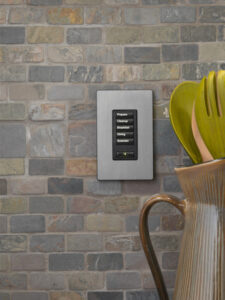
In addition, the larger, or simply more expensive, the home is, the more likely my experience has been that an interior designer will be involved in the project. While I’ve never met another interior designer that had the temper of the one involved in my first project, the challenges of integrating technology into an interior designer’s vision for the décor of a home can be challenging and cause conflicts.
Fortunately, there are companies making products today that allow technology to be hidden in a space rather than it being the dominant characteristic of it.
Smart Lighting
The realization of how important lighting is in a home, and the involvement of lighting designers in projects, has led to an increase in the number of lighting loads in a room. Task lights, accent lights, lights to illuminate artwork, lighting for wall wash effects, and more, are now becoming much more common in homes. In a room with a large number of lighting loads a wall can look like this.
However, a single multi-button keypad can be used to trigger lighting scenes that provide a homeowner with the day-to-day control they need without a wall full of switches. Should the need for additional adjustments to the lights arise, a smart phone app can be used.
Crestron and Lutron offer designer keypads that can control either individual loads or lighting scenes. They also offer custom engraving of the buttons so the function of each button can be permanently labeled on it. Crestron and Lutron systems don’t come cheap, but they offer the ability to integrate technology into a home and, at the same time, hide the fact that this is a hi-tech solution.

Motorized Shades/Drapes/Curtains
Installing motorized blinds, shades, and drapes isn’t the first choice for people starting to create a smart home. However, automating the operation of blinds, shades, and drapes has real advantages.
- Daylight harvesting – When the sun is not shining directly into a window the window treatment can be automatically opened to provide indirect light into the room that minimizes the need for using electrical lights during the day
- Solar heating – In the winter, smart window treatments can be opened to allow the sun to shine directly into a window to help heat a room. When the room gets too warm, or when the sun is no longer shining directly into the window, the window treatment can be closed to provide additional insulation against heat loss through the window (according to the U.S. Department of Energy about 30% of a home’s heating energy is lost through windows). In the summer, smart window treatments can be closed when the sun is shining directly into a window to reduce solar heat gain and save on the energy required for air-conditioning your home.
- Glare reduction – Smart window treatments can be closed when the sun is directly shining thorough a window to reduce glare
- Safety – Smart window treatments can be automatically opened during an emergency to make it easier for family members to exit the home if normal pathways are blocked by fire. It also allows first responders to see into the home to help find anyone who has not been able to get out by themselves. In the case of a burglary, opening window treatments allows neighbors and first responders to see what is happening in the home. Finally, having window treatments automatically closed in the evening keeps outsiders from knowing whether family members are home, or not.
- Privacy – It is very easy for passers by to see into a home at night when lights are on in the home. Smart window treatments can be automatically closed at sunset to protect the privacy of the homeowners.
- Security – Programming smart window treatments to open/close during the day can, just like programming smart lighting to periodically turn on/off, make potential thieves believe that someone is home.
- Protection of valuable furnishings – Smart window treatments can be closed when the sun is directly shining thorough a window to protect expensive furnishings and artwork from damage from the sun.
Today, there are a wide range of motorized shading solutions available. Even IKEA offers motorized roller shades that can be integrated with a smart home hub. In addition, there are manufacturers that offer motorized shades that:
- Are indistinguishable from their non-motorized counterparts
- Have a wide selection of material options to fit into any décor
- Are battery operated and wirelessly controlled so it isn’t necessary to run wiring to each window location
Again, Crestron and Lutron are premium providers of motorized shades. However, companies like Levolor, Hunter Douglas, and Graber also have motorized shading solutions at more modest prices. I wrote a detailed article on Graber’s Z-Wave, motorized, shade. For more information you can find that article here.
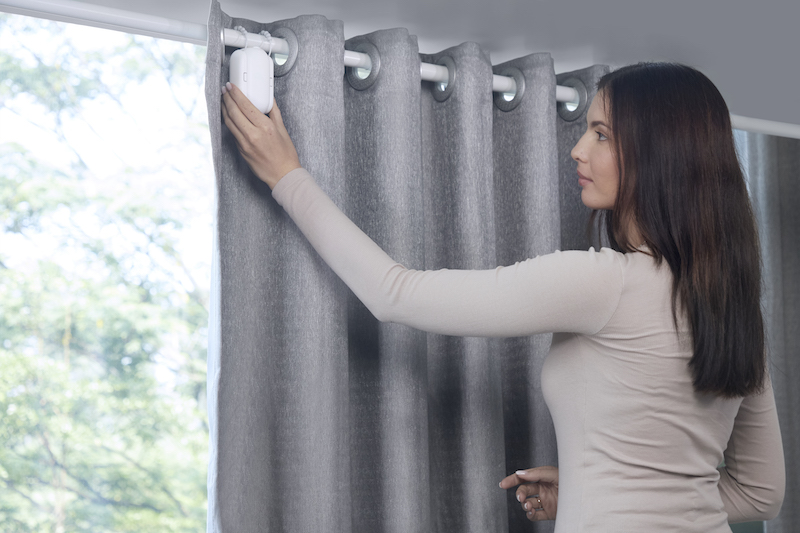
There are also a wide range of solutions for motorizing drapes and curtains. One solution is to install a motorized drapery track. Somfy is one manufacturer of this type of system. There are also retrofit solutions available from a variety of other manufacturers. Some of these are incredibly economical; such as the SwitchBot Curtain at only around $100.
For more information on this topic you can find an article I wrote about retrofit solutions for automating window coverings here.
Heating and Air Conditioning
Adding intelligence to the operation of a heating and air conditioning system can save a great deal of money on utility bills. But, unlike in years past, many people don’t have nine to five jobs that take them to an office every day. Instead people spend some time working at home, some time meeting with customers outside the home, some time in an office, there are days that the kids stay home from school and leverage computers for remote learning, and more. With this kind of chaotic schedule, a traditional “seven-day scheduling thermostat” that allows you to enter a fixed schedule to set back the daytime set point of the heating and air conditioning system is totally inadequate.
Fortunately there are a wide range of smart thermostats available from Amazon, Google Nest, Ecobee, Honeywell, and more. And, most of these thermostats are unobtrusive enough to not stand out in a home and clash with the home’s décor.
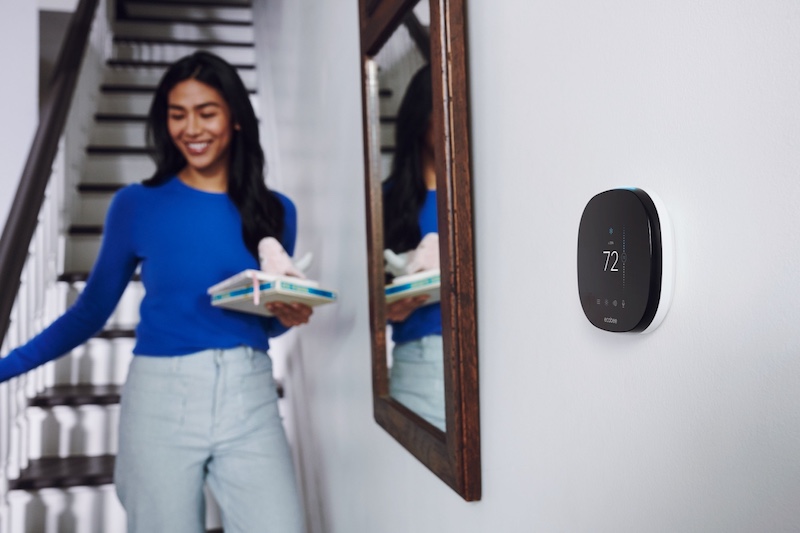
For those that want a completely hidden thermostat installation Crestron has a solution. Crestron offers a thermostat (DIN-THSTAT) that can be hidden away in a DIN rail cabinet. Crestron offers remote temperature (CHV-RTS) and temperature/humidity (CHV-RTHS) sensors that are wired back to the thermostat. The face of the sensor is 1-1/2” diameter, sits only 1/8” above the surface of a wall, and can be painted, or wall papered, to match the wall. This allows them to almost completely disappear from view.
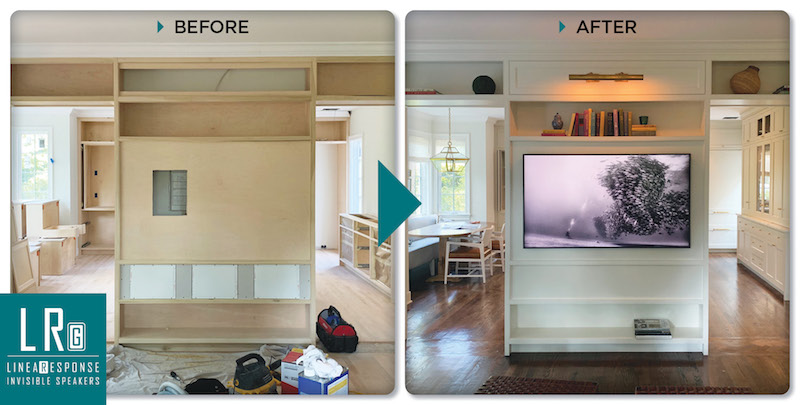
Speakers
Hiding speakers in a room can be very challenging. If you want your speakers to be completely invisible, then speakers from Stealth Acoustics offer a unique solution. Stealth Acoustics offers a wide range of speaker choices that are installed into the drywall of a wall and completely hidden from sight. Installation requires:
- Speaker wire to be run into the wall
- A hole in the drywall to be cut to fit the speaker in between two wall studs
- The speaker to be screwed to the studs
- Drywall tape applied around the speaker
- Drywall compound to be applied to blend the speaker into the surrounding drywall
- Optionally a skim coat of drywall compound can be applied over the entire speaker if a textured finish, such as Venetian plaster, is desired
- Careful sanding
- Painting
Once this process is complete the speakers are completely invisible.
There are other solutions for hiding standard speakers. Some options are:
- Placing them in large baskets with a weave that isn’t too tight so the sound isn’t muffled
- If the room is large enough, a false wall can be constructed and speakers hidden in the gap between the original wall and the new, false wall. Speaker cloth, that matches the paint color of the wall, can be used to finish the look
- Match the finish of the speakers and the color of the grill cloth with the media cabinet you choose to hold your electronics. Then place the speakers next to the media cabinet so they blend in and visually become part of the cabinet.
TV
Nothing can take over the décor of a room like a large TV on a wall. No matter how hard an interior designer works to, for example, create the perfect French provincial interior, a large TV will become the elephant in the room. Fortunately, there are several approaches that can be taken to overcome this.

TV Lift Cabinet is one company that sells cabinets that include a motorized TV lift. When the TV is off, it is completely hidden inside the cabinet. When the TV is turned on, the motorized lift is activated and it raises the TV from inside the cabinet for viewing. A built-in IR repeater system allows commands from the TV’s remote control to turn the TV on when it is hidden inside the cabinet. The TV is plugged into a current sensing outlet that activates the lift system to raise/lower the TV when it is switched on/off.
TV Lift Cabinet offers a wide range of cabinets in different styles and sizes. People often think that a cabinet that includes a motorized TV lift would only be available in a modern style. However, TV Lift Cabinet has models that will fit into a very traditionally styled home.
For those that want a more customized solution, TV Lift Cabinets can build a custom cabinet to your specifications, modify the size of one of their stock cabinets to fit your needs, or custom finish a cabinet to match other cabinetry in a room. In addition, the lift mechanisms can be purchased separately if you want to work with a local cabinetry shop to build a custom cabinet to match your décor.
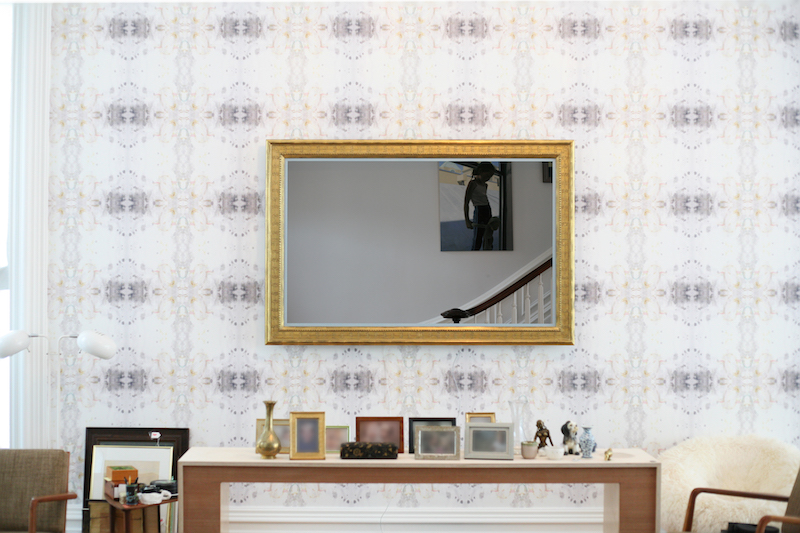
Another alternative is to turn your TV into a wall mirror by mounting a frame around the TV with a piece of “one-way” mirror in front of it. When the TV is off it looks like a high-end, framed wall mirror. When the TV is turned on the TV picture shines through the partially mirrored glass.
Reflectel is one company that custom builds mirror TV frames. They offer a wide range of finishing choices for their frames including wood, leather, metal, and even a gilded finish. And, unlike many other competing products, Reflectel offers a choice of different glass options. Their View glass is optical quality and offers 70% TV picture transmission and 30% reflectivity. At the other end of the scale, Reflectel offers more economical Look glass with 50% transmission of the TV image and 50% reflectivity. Reflectel has been featured in the Wall Street Journal, Forbes, and other magazines.
Another way to hide a TV in a room is to use it to display artwork when it isn’t being used for watching sports, movies, etc. Samsung’s Frame TV was specifically designed for this purpose. What makes the Frame TV different is the built-in art mode. When art mode is enabled the TV can display art from a large library that includes both modern and classic works. A user can even upload their own pictures to the TV for display. To complete the look, Samsung also offers several different frames that can be mounted to the outside of the Frame TV. Or, companies, such as Frame My TV offer premium frame options to fit the Frame TV.
If you want to turn your existing TV into an art display, or if you prefer a TV brand other than Samsung and want to use it to display art when the TV isn’t in use, then the BillionDollarArtGallery offers this option for almost any smart TV. It is a simple USB stick that can be inserted into a smart TV’s USB port. It provides a two-hour video slide show of some of the most famous paintings in the world from classical times to the early 20th century. Artworks are included from Leonardo da Vinci, Vincent van Gogh, Edgar Degas, and Winslow Homer; to name just a few. The product is well named. BillionDollarArtGallery estimates that if all the paintings included in the product came up for auction they might fetch as much as ten billion dollars. Just consider how much the Mona Lisa alone would sell for if it ever came up for auction.
Each painting displays for approximately 10 seconds. For about three seconds of that time a caption is displayed with the name of the painting, the artist’s name, the year when the painting was painted, and the name of the museum where the painting is displayed. Accompanying the display of the artwork is a classical soundtrack. If the music isn’t to your taste you can simply mute it.
The images are all formatted to a resolution of 3840 x 2160 with a black background. This matches the resolution of most TVs. The background is included so the TV won’t zoom in on the image and distort it from the shape the artist intended.
Images of all 500 individual paintings are included on the USB stick. This allows owners of the product to create their own collections for display. For example, a family with children might want to eliminate the display of paintings with nude images.
At the time of this writing, the BillionDollarArtGallery is currently selling for $39.99 on Amazon; making it the least expensive solution for helping to hide a TV in a room. Of course, the BillionDollarArtGallery could be combined with a picture frame around the TV to complete the look.
I had a chance to try the BillionDollarArtGallery. The product works very well, and the images are of very high quality. My only critique is that I wish it included more modern works of art from the 20th, and even 21st, century. However, I understand that more modern pieces of art have copyright protections associated with them and the licensing to include them in the product would drive up its price.
Finally, if you are handy with woodworking tools, there are easily found instructions on the Internet for creating your own picture frame around your TV. A quick Google search for “diy tv picture frame” will provide you with plenty of information and options. Combining this with the BillionDollarArtGallery provides a very economical solution for hiding a TV.
Summary
Smart home technology doesn’t need to take over the décor of a home. There is a wealth of options for hiding technology in a home.
- Multi-button smart keypads can trigger lighting scenes that operate multiple lighting loads in a room and eliminate a wall full of light switches
- Motorized window coverings offer a wide range of benefits in a home and come in a large variety of fabrics, materials, and styles to fit in with any décor
- Smart Thermostats can save energy, and money on utility bills. And, they aren’t any more intrusive to a home’s décor than older models
- There are many options for hiding speakers in a room including, models that mount into drywall, building them into a wall, and more
- Motorized lifts can hide a TV inside a cabinet. A TV can also be framed to look like a wall mirror and images of artwork can be displayed on the TV to make it a statement piece in the room instead of an eyesore
Some of these options can be costly but others are available at very reasonable prices.



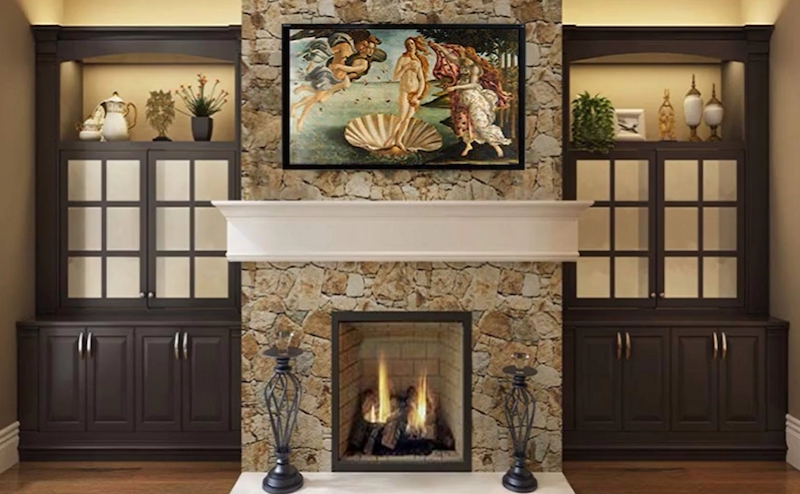



![ecobee premium airzone control The ecobee Smart Thermostat Premium. [Photo credit | ecobee]](https://restechtoday.com/wp-content/uploads/2025/06/ecobee-premium.jpg)
![Hub 3_02 The SwitchBot Hub 3 provides a user-friendly solution to the growing complexity of modern smart homes. [Photo credit | SwitchBot]](https://restechtoday.com/wp-content/uploads/2025/06/Hub-3_02-scaled-e1750179791687.png)
